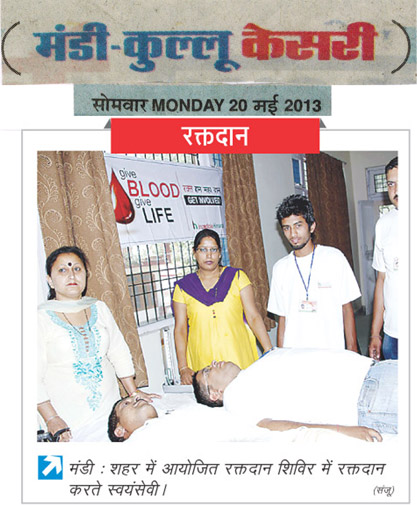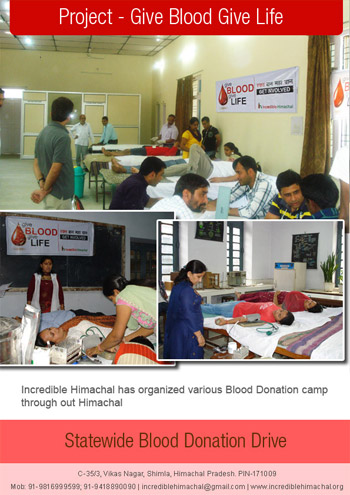Donating blood is an active way of helping others and the whole of society.
For you, it’s just a few moments out of your day but for patients in need, it may save their life. Specialist medical staff are on hand at all times during the donation, which is a simple, safe and painless procedure. There is no risk for donors of giving blood, and it may help patients to recover more quickly.
Blood Donation Camp at Mandi
Each donation may help up to three different people: Because each blood donation provides three different blood components, each with its own role in treating patients, it helps up to three different people. 
 Giving blood – make it a part of our routine. We don’t just need to give blood in the event of tragedies or emergencies. Instead, it should be a normal and routine part of our lives.
Giving blood – make it a part of our routine. We don’t just need to give blood in the event of tragedies or emergencies. Instead, it should be a normal and routine part of our lives.
Remember that:-
– men can give blood up to four times a year
– women up to three times
– providing there is at least two months gap between two successive donations.
Blood Groups
- Blood groups are substances linked to the membrane of many of the cells in our bodies. These include red blood cells (erythrocytes). The presence of these substances determines blood group and compatibility for blood transfusions.
- There are many blood groups but the two most important of these are theABO group and the Rh factor.
The ABO Group:
- This blood group is determined by sugars and comprises four groups based on their sugar composition: A, B, AB and O. The frequency of these groups is as follows:
| Blood group | Frequency (%) |
| O | 45 |
| A | 40 |
| B | 11 |
| AB | 4 |
- This blood group is determined by sugars and comprises four groups based on their sugar composition: A, B, AB and O. The frequency of these groups is as follows:
| A patient in group: | can receive blood from a donor in group: | |||
| 1st choice | 2ndchoice | 3rdchoice | 4thchoice | |
| AB | AB | A | B | O |
| A | A | O | ||
| B | B | O | ||
| O | O | |||
- This table illustrates that people with AB blood are universal recipients because they can receive blood from anybody, and those with O blood are universal donors because they can give blood to anybody.
Rh Factor:
- There are two types in every group: Rh positive and Rh negative. Rh positive people can only donate blood to Rh positive people, whereas Rh negative people can give blood to anybody, regardless of whether they are positive or negative.
There are several types of blood donation:
- Whole blood. This is the most common type of blood donation, during which approximately a pint of whole blood is donated. The blood is then separated into its components — red cells, plasma, platelets.
- Platelets. This type of donation uses a process called apheresis. During apheresis, the donor is hooked up to a machine that collects the platelets and some of the plasma, and then returns the rest of the blood to the donor.
- Plasma. Plasma may be collected simultaneously with a platelet donation, or it may be collected without collecting platelets during an apheresis donation.
- Double red cells. Double red cell donation is also done using apheresis. In this case, only the red cells are collected.
Our slogan is “Donate Blood , Save Life”


